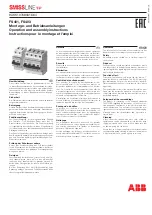
Powered by Safety
®
16
PowlVac® CDR 27kV & 38kV Vacuum Circuit Breaker
IB-65020A
Equipment Description
Each operating pushrod assembly
(Figure 2, g) encloses a contact loading
spring. At the end of this spring is a
pivot block. The pivot block is restrained
by a lock nut on a stud which passes
through the contact loading spring and
is attached to the operating pushrod
assembly. The contact loading spring has
initial compression such that as soon as
the vacuum interrupter contacts touch,
the springs are preloaded to a value
sufficient to resist vacuum interrupter
contact separation under the highest
electromagnetic forces exerted by the rated
short circuit current. Further movement
of the operating pushrod assembly
compresses the contact loading spring and
produces a gap between the face of the
pivot block and the lock nut. This
nut-gap is used to evaluate the erosion of
the vacuum interrupter contactors.
In the closing cam and fundamental
linkage positions shown in
(Figure 8, b & d), the contact loading
springs and the main opening springs are
both acting to compress the three (3) main
mechanism links. The jackshaft extends
from the left to the right side of the circuit
breaker frame and is supported at the main
circuit breaker frame side sheets and by
the mechanism. The outer operating levers
on the jackshaft have connections to the
circuit breaker opening springs
(Figure 6, a & f).
The fundamental linkage is restrained from
movement by the secondary trip prop
(Figure 9, c) acting on the primary trip
prop roller (Figure 9, k). A component of
force tends to make the primary trip prop
rotate upward, but it is restrained by the
secondary trip prop face acting on the
primary trip prop roller. The clearance
between the primary trip prop roller and
the secondary trip prop is controlled by the
primary trip prop adjusting screw
(Figure 9, l). When the trip shaft is rotated
by the action of the manual trip operator or
the primary shunt trip coil, the secondary
trip prop face moves downward and
permits the primary trip prop to rotate
upward, thus permitting the main linkage
to move upward and the jackshaft to rotate,
opening the circuit breaker. The jackshaft
levers engage the shock absorbers
(Figure 6, g), which controls the rebound
of the vacuum interrupter contacts on an
opening operation.
With the standard electrical control
scheme, as soon as the main closing spring
is discharged on a closing operation, the
charging motor is switched on to recharge
the springs. This leaves the main closing
cam in a position where a tripped linkage
can reset under the action of the reset
spring (Figure 7, w) and the primary and
secondary trip props can move into the
reset position. The reset spring stretches
between an extension of the main cam
roller pin and a spring support pin located
on the left mechanism side sheet. The latch
check switch, operated by a lever on the
trip shaft, will close as the secondary trip
prop reaches the fully reset position.
















































